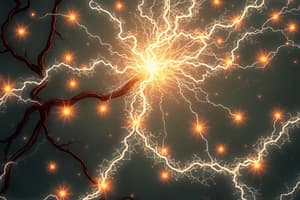Podcast
Questions and Answers
What is the charge of a proton?
What is the charge of a proton?
- Positive charge (correct)
- Negative charge
- Neutrons
- No charge
What is the charge of an electron?
What is the charge of an electron?
- Negative charge (correct)
- Positive charge
- Protons
- No charge
Which particles are carriers of positive charges in an atom?
Which particles are carriers of positive charges in an atom?
- Neutrons
- Coulombs
- Electrons
- Protons (correct)
Which particles are carriers of negative charges in an atom?
Which particles are carriers of negative charges in an atom?
What is the SI unit for measuring the magnitude of an electric charge?
What is the SI unit for measuring the magnitude of an electric charge?
Which particle is roughly 2000 times lighter than the mass of a proton or neutron?
Which particle is roughly 2000 times lighter than the mass of a proton or neutron?
What happens to the charge on sphere A as the balloon is pulled away?
What happens to the charge on sphere A as the balloon is pulled away?
According to the Law of Conservation of Charge, what was the overall charge of the system of two spheres before the charging process?
According to the Law of Conservation of Charge, what was the overall charge of the system of two spheres before the charging process?
What is the quantity of positive charge on sphere A equal to after induction charging?
What is the quantity of positive charge on sphere A equal to after induction charging?
What is the overall charge of the system of two spheres after the charging process?
What is the overall charge of the system of two spheres after the charging process?
Which statement correctly describes what happens to charge during an induction charging process?
Which statement correctly describes what happens to charge during an induction charging process?
What does it mean when we say atoms are electrically neutral?
What does it mean when we say atoms are electrically neutral?
What is the principle of conservation of charge?
What is the principle of conservation of charge?
When a plastic rod is rubbed with fur, what type of charge does the rod acquire?
When a plastic rod is rubbed with fur, what type of charge does the rod acquire?
What is meant by the quantization of electric charge?
What is meant by the quantization of electric charge?
In terms of charge, what is a natural unit of charge?
In terms of charge, what is a natural unit of charge?
How does the total electric charge change when a plastic rod and fur are rubbed together?
How does the total electric charge change when a plastic rod and fur are rubbed together?
How many electrons are there in one coulomb of negative charge?
How many electrons are there in one coulomb of negative charge?
Study Notes
Charges of Subatomic Particles
- The charge of a proton is positive.
- The charge of an electron is negative.
Charge Carriers in an Atom
- Protons are carriers of positive charges in an atom.
- Electrons are carriers of negative charges in an atom.
Measuring Electric Charge
- The SI unit for measuring the magnitude of an electric charge is the coulomb (C).
Mass Comparison
- An electron is roughly 2000 times lighter than the mass of a proton or neutron.
Induction Charging
- When a balloon is pulled away, the charge on sphere A remains the same.
- According to the Law of Conservation of Charge, the overall charge of the system of two spheres before the charging process is zero.
- The quantity of positive charge on sphere A after induction charging is equal to the quantity of negative charge on sphere B.
- The overall charge of the system of two spheres after the charging process remains zero.
- During an induction charging process, charge is not created or destroyed, but rather transferred from one object to another.
Electrical Neutrality of Atoms
- When we say atoms are electrically neutral, it means they have an equal number of protons and electrons.
Principle of Conservation of Charge
- The principle of conservation of charge states that the total electric charge of an isolated system remains constant over time.
Charge Acquired by Rubbing
- When a plastic rod is rubbed with fur, the rod acquires a negative charge.
Quantization of Electric Charge
- The quantization of electric charge means that electric charge comes in discrete, natural units, rather than being continuous.
- In terms of charge, a natural unit of charge is the charge of a single electron or proton.
Charge Change During Rubbing
- The total electric charge does not change when a plastic rod and fur are rubbed together.
Electric Charge and Electrons
- There are approximately 6.24 x 10^18 electrons in one coulomb of negative charge.
Studying That Suits You
Use AI to generate personalized quizzes and flashcards to suit your learning preferences.
Description
Test your knowledge on the principle of conservation of charge and the process of charging objects by rubbing them together. Explore how the total electric charge remains constant in a closed system. Prepare to understand the concept of positive and negative charges through practical examples.




